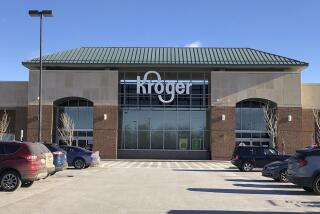Changing Face of Supermarkets
- Share via
It has been said that no institution in the United States tells us as much about ourselves as the supermarket.
The graying of America, the move toward a service-oriented economy, the emergence of new ethnic groups and the expanding role of women in the labor market have all had an impact on the supermarket shelf.
Today, the leading supermarkets tell us that consumers are no longer dominated by national brands or tastes.
In the 1990s, new consumer tastes and life styles are only the most visible of the changes that are rewriting the rules for the supermarket business. What was once the conventional supermarket will, before the decade is over, become quite unconventional by today’s standards. Already these stores are being challenged by such competitors as hypermarkets, wholesale clubs, discount stores and grocery-outlet stores. Hypermarkets are huge, combination discount-retail and grocery stores.
Meanwhile, manufacturers can no longer depend on “national” tastes to support national brands. Changing demographics, ethnic population bases and life styles all have helped make the mass market less relevant. Now, regional--even local--tastes and economics are more important in the food industry than in perhaps any other retailing business. This helps to explain why few American supermarket chains can compete successfully in several metropolitan markets and why chains such as A&P;, Safeway and Kroger have pulled out of many cities while focusing on particular regions. Simultaneously, such companies as Albertson’s, Vons and Ralphs have developed several formats to fit local market conditions and real estate economics.
Apart from changes in consumer tastes, two other factors have played a strong role in regionalization in recent years. The first is higher freight and distribution costs. Because of deregulation of the trucking industry and the reduced control of unions over distribution centers, retailers can serve regional areas economically, but they have a harder time maintaining warehouses in several parts of the country. And as stores turn over more space to perishable items--seafood counters, salad bars, delis, bakeries and flower shops--distribution centers that can respond faster and more frequently have become even more important.
A second change driving regional concentration has been advertising. In the 1980s, the costs of conventional advertising (TV, radio, newspapers) increased faster than the supermarket industry’s ability to raise prices. This has forced retailers to concentrate stores in large urban areas to get the most out of their advertising dollar. The loss of many TV viewers to cable and VCRs also has made national advertising campaigns less cost effective.
If they are to survive and prosper in this new retailing world, manufacturers and retailers will have to find the best ways to reach target markets and to customize not only products but also packaging, pricing, promotions and support systems. And while retailers are trying to respond even faster to consumer whims, they will have to keep perishable inventories to a minimum.
The only way to do all this effectively will be through technology. Retailers are just beginning to tap the full potential of their investment in technologies such as scanning equipment and warehouse information systems. Besides ringing up the price of an item on the cash register, scanners will provide detailed receipts, eliminating cashier mistakes and letting customers review individual prices and ask for subtotals. Scanners also will give store managers minute-by-minute details of purchases and automatically generate orders to replenish stock.
At the same time, the complex information and management systems installed in the 1990s will help stores improve operating performance and return on assets. Often these systems will be tied into suppliers’ systems to cut costs and increase efficiency.
Much of the information generated by scanners, as well as other information, will be fed into another form of technology: electronic data interchange (EDI). A $300 delivery of potato chips may require the same paper work as a $30,000 warehouse delivery, so using EDI to exchange ordering, billing, shipping and receiving information among retailers and suppliers will return significant benefits, particularly in the elimination or improvement of time-consuming, error-producing clerical work.
EDI will also find a use in the home. It has been estimated that by the mid-1990s, one-third of all grocery shopping will be done through interactive home videotext communications devices, with payment via a debit card. EDI systems will create the networks that provide banking and at-home (even in-car) shopping services.
As retailers use scanners and EDI systems to build elaborate federations of linked companies and meet customers’ changing needs and tastes, food manufacturers will be forced to go along. They will have to invest in the technologies that allow them to participate in these federations.
In sum, the burden has shifted. Retailers that survived the restructuring of the food industry in the 1980s are stronger and more sophisticated. They will control the 1990s. Manufacturers, who used to simply offer products and expect retailers to find shelf space for them, will also have to develop strategies for different markets and population groups, increase marketing expenses to support those strategies and invest in the technology required to meet retailers’--and consumers’--needs.
More to Read
Inside the business of entertainment
The Wide Shot brings you news, analysis and insights on everything from streaming wars to production — and what it all means for the future.
You may occasionally receive promotional content from the Los Angeles Times.










